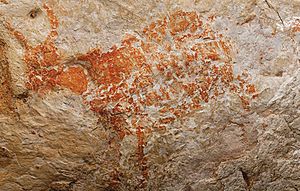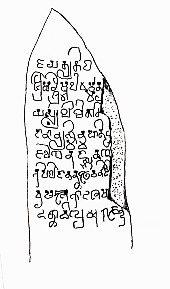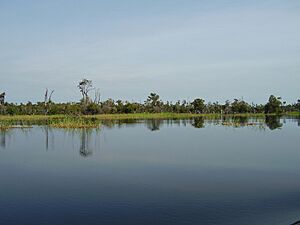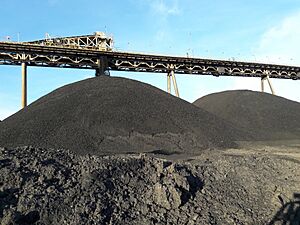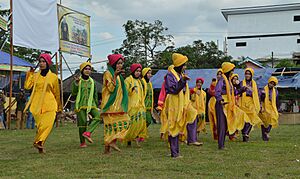East Kalimantan facts for kids
Quick facts for kids
East Kalimantan
Kalimantan Timur
|
||
|---|---|---|
| Province of East Kalimantan | ||
|
||
| Nickname(s):
Benua Etam (Tenggarong Kutai Malay)
"Place of origin" |
||
| Motto(s):
روحوي رحايو (Banjar)
Ruhui Rahayu "Perfect harmony by the blessings of God" |
||
![Location of East Kalimantan (dark red)[Legend]](/images/thumb/1/10/East_Kalimantan_in_Indonesia.svg/300px-East_Kalimantan_in_Indonesia.svg.png)
Location of East Kalimantan (dark red)
[Legend] |
||
|
OpenStreetMap
|
||
| Capital and largest city |
Samarinda | |
| Government | ||
| • Body | East Kalimantan Provincial Government | |
| Area | ||
| • Total | 127,346.92 km2 (49,168.92 sq mi) | |
| Area rank | 3rd in Indonesia | |
| Highest elevation
(Mount Cemaru)
|
1,636 m (5,367 ft) | |
| Population
(mid 2023 estimate)
|
||
| • Total | 4,030,488 | |
| • Density | 31.649670/km2 (81.972269/sq mi) | |
| Demographics | ||
| • Ethnic groups | 20% Javanese 20% Kutai 19% Malays 18% Buginese 14% Banjarese 9.9% Dayak |
|
| • Languages | Indonesian (official) Banjarese, Buginese, Dayak, Kutai Malay (regional) |
|
| Time zone | WITA (UTC+8) | |
| GDP (nominal) | 2022 | |
| - Total | Rp 921.3 trillion (7th) US$ 62.1 billion Int$ 193.6 billion (PPP) |
|
| - Per capita | Rp 238.7 million (2nd) US$ 16,075 Int$ 50,162 (PPP) |
|
| - Growth | ||
| HDI | ||
East Kalimantan is a large province in Indonesia, located on the eastern part of the island of Borneo. It's known for its vast rainforests and rich history. As of mid-2023, about 4 million people live here. Its capital city is Samarinda.
East Kalimantan covers a huge area of about 127,346 square kilometers. It's one of the least crowded provinces in Kalimantan. To the east, it has a long coastline along the Makassar Strait and the Celebes Sea. It shares land borders with West Kalimantan, Central Kalimantan, and South Kalimantan. To the north, it borders North Kalimantan, which used to be part of East Kalimantan until 2012. It also shares a border with Sarawak in Malaysia.
The province is divided into seven smaller areas called regencies and three cities. The current acting governor of East Kalimantan is Akmal Malik.
Contents
Indonesia's New Capital City
East Kalimantan is a very special place because it will be home to Indonesia's future capital city, named Nusantara. This new city is being built between the Kutai Kartanegara and Penajam North Paser areas. The plan is for Nusantara to become the official capital in August 2024. It's a huge project that will help spread development across Indonesia.
History of East Kalimantan
Ancient Times
Long, long ago, East Kalimantan was covered in thick tropical rainforests. Deep inside a limestone cave called Lubang Jeriji Saléh, scientists found some of the oldest known cave paintings in the world! These amazing drawings of animals are over 40,000 years old, maybe even 52,000 years old. Explorers first saw them in 1994, and in 2018, scientists confirmed their incredible age using special dating methods.
Early Kingdoms (4th to 17th Century)
East Kalimantan was home to some of Indonesia's earliest kingdoms. The first and oldest Hindu kingdom in Indonesia, called the Kingdom of Kutai Martadipura, was founded here in the 4th century AD. Later, in the 14th century, it was followed by the Sultanate of Kutai ing Martadipura. Other kingdoms, like the Sultanate of Pasir, also existed in this region. For a while, parts of East Kalimantan were even connected to the powerful Majapahit empire and later had ties with the Sulu Sultanate and the Sultanate of Makassar.
Dutch Influence (18th to 20th Century)
Starting in the early 1800s, the Dutch East Indies began to take control of East Kalimantan. The local sultans gradually handed over territories to the Dutch. By 1846, the Dutch had set up an office in Samarinda to manage the area. East Kalimantan officially became a province of Indonesia in 1956, after Indonesia gained its independence.
North Kalimantan Splits Off
On October 25, 2012, a new province called North Kalimantan was created. It was formed from the northern parts of East Kalimantan, including four regencies and one city. This made East Kalimantan a bit smaller, but it still remains a very important province.
Geography
East Kalimantan covers a large land area and also includes a significant ocean area. It's located near the equator, which affects its climate. The province is divided into seven regencies and three cities. These are further split into smaller districts and villages.
East Kalimantan is like a gateway to the eastern part of Indonesia. It's famous for its timber and mining resources. Many rivers flow through the province, serving as important ways to travel, especially the long Mahakam River.
The province has hills in almost all its districts and many lakes. The biggest lakes, Semayang and Melintang, are found in the Kutai Regency.
Climate
Like most of Indonesia, East Kalimantan has a tropical climate with two main seasons: a dry season and a rainy season. The dry season usually lasts from May to October, while the rainy season is from November to April. Because it's so close to the equator, the climate is also influenced by monsoon winds. Sometimes, the weather can be a bit unpredictable, with rain when it should be dry, or vice versa.
Temperature and Humidity
East Kalimantan generally has a warm climate. Temperatures usually range from about 21°C to 35°C throughout the year. The air is often quite humid, usually between 83% and 87%, because of the tropical forests and proximity to the ocean.
Rainfall and Wind
The amount of rain in East Kalimantan changes depending on the month and location. On average, the province receives a good amount of rainfall each year. Winds in the region are generally light, usually blowing at speeds between 3 and 4 knots.
Government and Divisions
When East Kalimantan province was first formed, it had four regencies and two cities. Over time, more cities and regencies were created as the population grew and the area developed.
In 2012, the northern parts of East Kalimantan became the new province of North Kalimantan. This changed the number of regencies and cities in East Kalimantan. Today, East Kalimantan has seven regencies and three cities. These areas are listed in the table below with their populations.
| Kode Wilayah |
Name of City or Regency |
Area in km2 |
Pop'n 2010 census |
Pop'n 2015 census |
Pop'n 2020 census |
Pop'n mid 2022 estimate |
Capital | HDI 2019 |
|---|---|---|---|---|---|---|---|---|
| 64.01 | Paser Regency | 11,603.94 | 230,316 | 261,736 | 275,452 | 303,424 | Tanah Grogot | 0.723 (High) |
| 64.02 | West Kutai Regency (Kutai Barat) |
20,384.60 | 140,097 | 145,728 | 172,288 | 177,007 | Sendawar | 0.716 (High) |
| 64.03 | Kutai Kartanegara Regency | 27,263.10 | 626,680 | 716,319 | 729,382 | 788,113 | Tenggarong | 0.738 (High) |
| 64.04 | East Kutai Regency (Kutai Timur) |
31,239.84 | 255,637 | 318,950 | 434,459 | 455,504 | Sangatta | 0.735 (High) |
| 64.05 | Berau Regency | 36,962.37 | 179,079 | 208,394 | 248,035 | 280,998 | Tanjung Redeb | 0.749 (High) |
| 64.09 | Penajam North Paser Regency (Penajam Paser Utara) |
3,333.06 | 142,922 | 154,020 | 178,681 | 196,566 | Penajam | 0.716 (High) |
| 64.11 | Mahakam Ulu Regency (Mahakam Ulu) |
18,427.81 | 24,994 | 25,946 | 32,513 | 38,498 | Ujoh Bilang | 0.676 (Medium) |
| 64.71 | Balikpapan City | 511.01 | 557,579 | 614,663 | 688,318 | 738,532 | Balikpapan | 0.801 (Very High) |
| 64.72 | Samarinda City | 718.00 | 727,500 | 811,314 | 827,994 | 861,878 | Samarinda | 0.802 (Very High) |
| 64.73 | Bontang City | 161.88 | 143,683 | 165,606 | 178,917 | 189,968 | Bontang | 0.801 (Very High) |
| Totals | 127,346.92 | 3,028,487 | 3,422,676 | 3,766,039 | 4,030,488 | Samarinda | 0.766 (High) |
Protecting the Environment
Sadly, a lot of the original forests in East Kalimantan have been cut down due to illegal logging. Less than half of the old forests remain, even in important places like the Kayan Mentarang National Park and the Kutai National Park.
Many groups are working to protect the remaining tropical rainforests. For example, the WWF has projects here. Also, the Borneo Orangutan Survival Foundation runs a place called Samboja Lestari, where they replant trees and help orangutans get back to living in the wild.
Economy
East Kalimantan GDP share by sector (2022) Agriculture (7.04%) Manufacturing (15.05%) Other Industrial (7.79%) Mining and Quarrying (53.24%) Service (16.88%)
East Kalimantan's economy mostly depends on its natural resources. This includes oil, natural gas, coal, and gold. The city of Balikpapan has an important oil refinery that processes crude oil.
Other parts of the economy that are growing include farming and tourism.
One challenge for the economy is that transportation can be difficult. Many people still rely on traditional boats to travel between cities along the coast and on the Mahakam River. However, new projects, like railway lines, are being built to help transport coal and other goods.
People and Culture
Ethnic Groups
| Ethnicities of East Kalimantan – 2010 Census | ||||
|---|---|---|---|---|
| Ethnic group | Percentage | |||
| Javanese | 29.55% | |||
| Bugis | 18.26% | |||
| Banjar | 13.94% | |||
| Dayak | 9.91% | |||
| Kutai | 9.21% | |||
| Sundanese | 1.59% | |||
| Madurese | 1.24% | |||
| Chinese | 1.16% | |||
| Toraja | 1.16% | |||
| Others | 13.18% | |||
East Kalimantan is home to many different ethnic groups. The largest group is the Javanese, who have moved here from other parts of Indonesia. The second largest group is the Bugis, followed by the Banjar people, who are very common in cities like Samarinda and Balikpapan.
The Dayak people are the fourth largest group and live mostly in the inner parts of the province. The Kutai people, who are native to this region, are the fifth largest group. Many people from other islands like Java, Sulawesi, and South Kalimantan have moved to East Kalimantan, making it a very diverse place.
Languages
Most people in East Kalimantan use Indonesian for official things. For everyday talks between different groups, the Banjarese language is often used, especially in cities. You'll also hear Javanese and Buginese because many people from those groups live here.
Other languages spoken in East Kalimantan include Kutai Malay, Paser, Tidung, and various Dayak languages. Some of these local languages are becoming less common, and efforts are being made to protect them.
Religions
Religion in East Kalimantan (2022) Islam (87.44%) Protestantism (7.49%) Roman Catholic (4.44%) Buddhism (0.39%) Hinduism (0.22%) Confucianism (0.01%) Folk religion (0.01%)
Most people in East Kalimantan are Muslim. There are also many Christians (both Protestant and Roman Catholic), as well as smaller communities of Buddhists, Hindus, and followers of other beliefs. People of different faiths generally live together peacefully.
Images for kids



